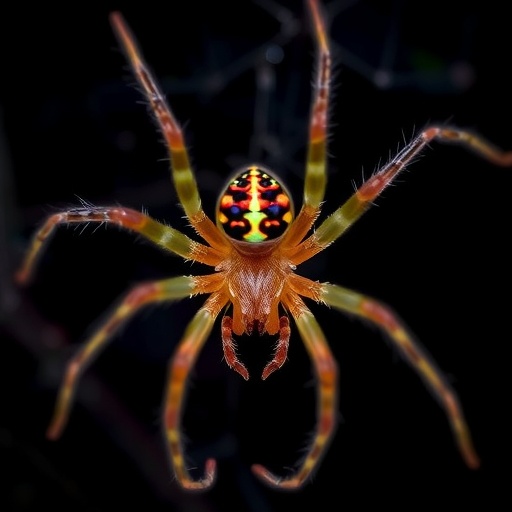In a groundbreaking discovery that sheds new light on the biodiversity hidden within California’s iconic coastal ecosystems, researchers at the University of California, Davis have identified a previously unknown species of trapdoor spider, Aptostichus ramirezae, lurking quietly beneath the sands of the coastal dunes. This revelation not only enriches our understanding of arachnid diversity in the region but also underscores the cryptic complexity of species that can remain concealed even in well-studied habitats. The finding was detailed in a recent publication of Ecology and Evolution, which also illustrates how molecular techniques continue to revolutionize taxonomy and species delineation.
Trapdoor spiders, belonging to the family Euctenizidae, represent a fascinating group of mygalomorph spiders closely related to tarantulas yet markedly different in behavior and physiology. Typically, female trapdoor spiders construct subterranean burrows lined with silk and cap them with a hinged “trapdoor” camouflaged against the environment. This behavioral adaptation remains central to their survival strategy, enabling them to ambush prey with remarkable efficiency. These spiders’ discreet, fossil-like lifestyle has long posed challenges to biological surveys, contributing to the discovery of cryptic species such as Aptostichus ramirezae.
The newly identified Aptostichus ramirezae was initially mistaken for its close relative, Aptostichus simus, a species with a broad distribution spanning from Monterey, California, down through Baja California, Mexico. However, detailed genomic analyses conducted by doctoral researcher Emma Jochim and her team unveiled significant genetic divergence between populations previously grouped under A. simus. These genetic differences, coupled with distinct geographical segregation, prompted researchers to classify A. ramirezae as a novel cryptic species, genetically distinct yet morphologically indistinguishable from its cousin.
The study’s methodological approach highlights the power of integrating population genomics with ecological distribution data to decipher complex speciation patterns. By sequencing mitochondrial and nuclear DNA markers from specimens collected along the extensive coastal dune habitats, the researchers identified clear genetic lineages that conform to distinct evolutionary units. This approach underpins a growing recognition in evolutionary biology: cryptic speciation is often masked by morphological stasis but can be elucidated through molecular signatures—a critical insight for biodiversity assessment and conservation.
Ecologically, both Aptostichus simus and Aptostichus ramirezae occupy highly specialized niches within coastal sand dune ecosystems. These coastal dunes represent unique, fragile environments characterized by dynamic sediment movement, salt spray, and specialized plant communities. The spiders’ dependence on such specific habitats confers ecological vulnerability, especially considering the rapidly changing environmental conditions driven by anthropogenic factors. Urban development, coastal erosion, wildfire prevalence, and the ominous prospect of sea-level rise present escalating threats to these sandy refuges and their endemic inhabitants.
This discovery accentuates an urgent conservation message. Trapdoor spiders, due to their limited dispersal capabilities and sedentary lifestyles, are inherently poor colonizers of new habitats. As such, their populations are fragmented and genetically isolated, amplifying their sensitivity to habitat loss. Aptostichus simus, for instance, now demonstrates a severely restricted presence mainly localized near San Diego, an area highly susceptible to sea-level rise and urban encroachment. Conversely, Aptostichus ramirezae maintains a broader range but nonetheless faces similar pressures.
The taxonomic naming of the new species carries its own narrative significance. Professor Jason Bond, a renowned arachnologist from UC Davis known for integrating cultural references into species nomenclature, named the species Aptostichus ramirezae in honor of Dr. Martina Giselle Ramirez, a distinguished arachnologist. Dr. Ramirez’s pioneering contributions to trapdoor spider population genetics and her advocacy for underrepresented groups in STEM have made her an influential figure in arachnology and science education. This homage underscores the human stories interwoven with scientific discovery.
Beyond the immediate biological intrigue, the research highlights significant implications for conservation policies. Identification of cryptic species complicates conservation efforts because overestimating species’ ranges can lead to misinformed management strategies. Pinpointing genetically distinct populations that warrant separate protection helps prioritize interventions to safeguard biodiversity hotspots. In the context of climate change and habitat fragmentation, such precision in conservation biology is increasingly indispensable.
Moreover, this discovery lends a fascinating perspective on global spider diversity. With over 50,000 described spider species worldwide, scientists estimate that many hundreds of thousands remain undocumented, lurking in understudied or inaccessible habitats. The revelation that even accessible regions like California’s coastal dunes harbor cryptic species challenges assumptions about biodiversity comprehensiveness and stresses the necessity for continuous, integrative taxonomic research.
Studying such inconspicuous organisms has broader ramifications beyond academic curiosity; it directly informs ecosystem health and resilience. Spiders, as generalist predators, play crucial roles in regulating insect populations and maintaining ecological balance. The presence, absence, or decline of species like trapdoor spiders can serve as bioindicators reflecting the cumulative impacts of environmental changes. Therefore, uncovering hidden species diversity holds pragmatic value for ecosystem monitoring and management.
The expedition for this discovery was supported by the National Science Foundation, emblematic of sustained investment in fundamental biological research. The collaborative effort between graduate students and faculty at UC Davis demonstrates the importance of academic mentorship and interdisciplinary inquiry in unveiling biodiversity’s hidden layers. As scientific tools evolve, combining fieldwork, genomics, and ecological modeling promises to unravel more secrets in the natural world.
This discovery story, therefore, encapsulates the dynamic interplay of evolutionary genetics, ecology, conservation, and human dimension in contemporary biodiversity science. Aptostichus ramirezae, a spider that might once have been overlooked beneath the sand, now stands as a symbol of nature’s cryptic complexity and the urgent need to understand and protect our planet’s living heritage before it slips away unseen.
Subject of Research: Animals
Article Title: Speciation Pattern and Process in the California Coastal Dune Endemic Trapdoor Spider Aptostichus simus (Mygalomorphae: Euctenizidae) and Description of a New Cryptic Species
News Publication Date: 22-Oct-2025
Web References: https://dx.doi.org/10.1002/ece3.72346
Image Credits: Emma Jochim/UC Davis
Keywords: Aptostichus ramirezae, trapdoor spider, cryptic species, coastal dunes, speciation, biodiversity, genomics, California ecology, conservation biology, habitat loss, molecular taxonomy, Arachnology




